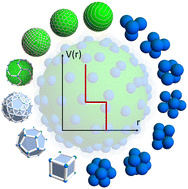Packing core–corona particles on a spherical surface†
Abstract
We explore the non-trivial structures that can be obtained by the assembly of repulsive core–corona particles confined on a spherical surface. Using Monte Carlo simulations, we study the low-temperature equilibrium configurations as a function of the size of the confining (spherical) surface for a small number of particles (N ≤ 12) and obtain a large variety of minimal-energy arrangements including anisotropic and chiral structures. For a small cluster (N = 4), we construct a phase diagram in the confining surface radius vs corona range plane that showed regions where configurations with a certain energy are not accessible. Also, a phase diagram in the temperature and confining surface radius plane showed the presence of reentrant phases. The assembly of Platonic and Archimedean solids and the emergence of helical structures are also discussed. When the number of particles is large (N ≥ 100), apart from the appearance of defects, the overall configurations correspond closely to the ones formed in an unconfined two-dimensional case. Interestingly, the present model reproduces the symmetry of experimentally obtained small clusters of colloidal spheres confined at the surface of evaporating liquid droplets which cannot be explained in terms of packing of hard spheres. Thus, our simulations provide insight on the role that the softness of the particles may have in the assembly of clusters of nanoparticles.

- This article is part of the themed collection: Soft Matter Editorial Board Highlights of 2022


 Please wait while we load your content...
Please wait while we load your content...